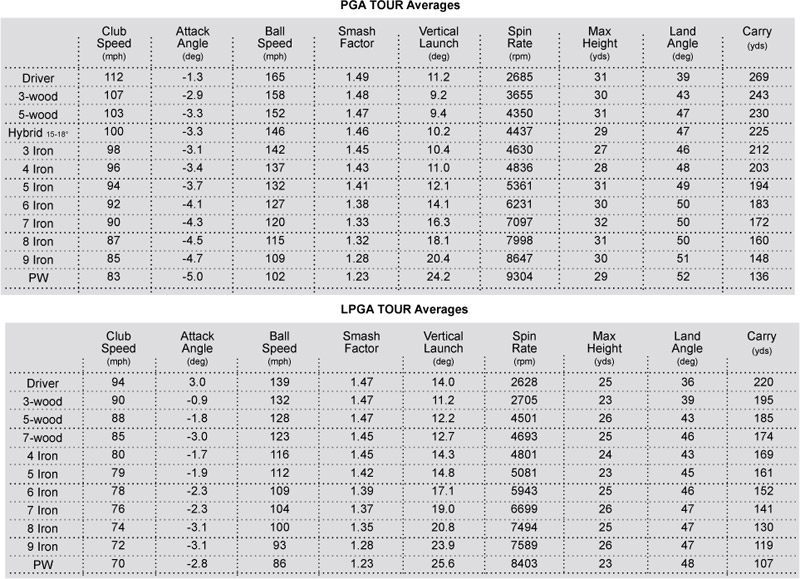1. Get my driver clubhead speed to ‘match’ my irons clubhead speed.
The last time I got onto Trackman, my 5-iron clubhead speed was 94-96 mph and my 7-iron clubhead speed was 90-92 mph. That’s roughly 0-2 mph more than the PGA Tour average.
(CLICK TO ENLARGE)

The problem was the driver clubhead speed was at about 108 mph. Thus, I would like to get the clubhead speed more in the 112-114 mph range.
2. Get the attack angle on the driver at -1.5* or shallower.
As you can see from the data, the PGA Tour average is at -1.3*. My current AoA is about -2 to -3*. As I wrote in the 2011 Pro Golf Synopsis, I do believe one can benefit greatly if they can hit the ball of the tee with the driver, by hitting up or down on the ball on command. But for now, I’ll take baby steps with the attack angle.
3. Become an excellent 3-wood player.
In 2011 Pro Golf Synopsis, I discussed my feelings on the importance of 3-wood play. My belief is that with the driver, distance is a good thing as long as you don’t leave yourself with an impeded shot. However, since we typically lose distance using a 3-wood off the tee and leaving the driver in the bag, we should expect more from the tee shot accuracy using a 3-wood off the tee. My goal is to increase my usage of the 3-wood in comparison to the hybrid (20*). And I want to hit 80% of my fairways when I use a 3-wood off the tee. I have not factored in a goal for getting an official ‘Go For It’ on par-5’s where the ball is within 30 yards of the edge of the green after the 2nd shot. But, it’s something I want to investigate and then establish a goal to achieve.
4. Investigate best method of tee shots on par-4’s and par-5’s.
Another topic in Pro Golf Synopsis is the type of tee shot one should favor on long par-4’s and par-5’s. I believe I’ve become too aggressive on par-5 tee shots and it has hurt my expected score over time. I also believe I’ve tried to hit long par-4 tees into the Safe Zone and have hit too many errant tee shots, which have also increased my expected score.
5. Find the best driver that fits my swing over the course of the year.

As my swing progresses, I believe that will change the dynamics of the swing and the type of equipment that fits me. I think the MOI fitting has helped tremendously, but now I need to improve the fitting for the shaft profile and my swing along with the characteristics of the clubhead. I slacked off a bit here in 2011 and wound up with drivers that were too light for me then too heavy and spun too much. I would like to keep on top of this throughout the entire year.
6. Goals for Danger Zone Play
I figure the PGA Tour average GIR % from the Danger Zone is about 50%. Obviously, they are playing more difficult courses than I play, so I would like to set the goal at 55%. I believe this takes good swing mechanics, practice, and good club fitting. I recently changed the MOI of my irons and found it to be a dramatic help, but also discovered that the lie angles with my Danger Zone clubs were about 1-2* too upright.
7. Get My Average Impeded Shots per Round to under 3.0.
Simple, lower your average amount of Impeded Shots per round, your scores will lower as well.
8. Get AimPoint Calculation Errors to 75%
What I mean is that if I read a putt and calculate the break at 10 inches right of the cup, I’ll ‘accept’ a mis-calculation that is 25% off (7.5 inches to 12.5 inches). The difficulty when doing AimPoint becomes when the percentage of slope changes and it gets even more difficult when the slope changes direction. On a planar slope that does not have any noticeable change in the percentage of slope, the reads are pretty easy and I usually get them correct.
9. Get Most of the AimPoint Errors Down to Speed and/or Mis-Aim error
As I have stated in previous posts, I count the errors with AimPoint as:
a. General Mis-Read Error (putt breaks one way, but mis-read it to break the other way).
b. 'Gross' calculation errors (putt breaks 10 inches left, user had it breaking 4 inches left).
c. Aim Perception Errors (user thinks they are aiming 10 inches right of the cup and are instead 15 inches right of the cup).
d. Aiming Errors (user thinks they are aiming at target, but are not aimed at the target).
e. Speed/Touch errors
I think if the majority of my errors wind up being 'd' and 'e', I think I can become an excellent putter.
3JACK
1 comment:
interested to see how you get your SS up.
Post a Comment